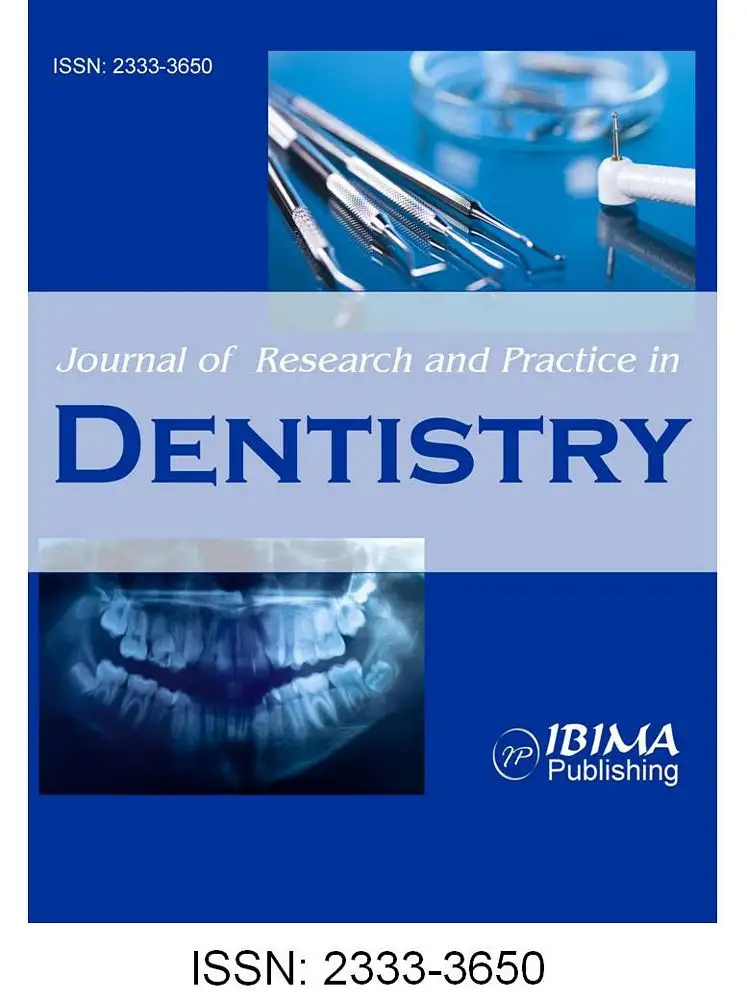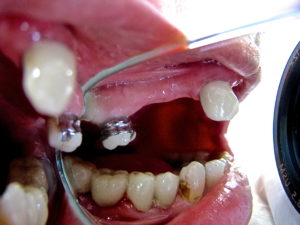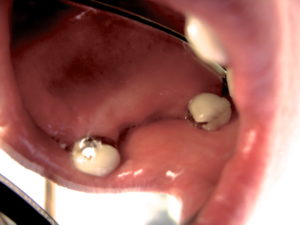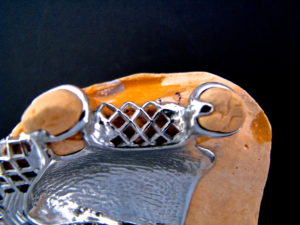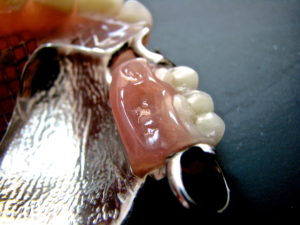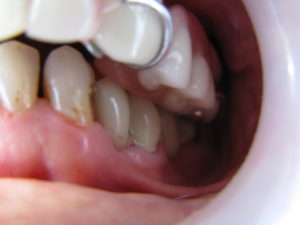Prosthesis İs still in service and the patient İS pleased after twelve months of insertion. Improvements in esthetics, speak intelligibility, chewing and deglutition are achieved.
Discussion
Prosthetic treatment of a patient having a huge maxillofacial defect was described in the present paper. The patient was exhibiting a midfacial lateral defect including the absence of the maxillary and orbital tissues. Moreover, the functions and the abilities were more complicated due to the mediotrusion of the remaining mandible due to the mandibular resection. Such large maxillofacial defects have not been reported frequently in maxillofacial prosthetic literature. Federspil (2009) reported that, the large maxillo-facial defects could result in serious functional impairment of speech, mastication, and swallowing. The cosmetic disfigurement often has a significant psychological impact. Acceptable esthetic appearance usually can be regained. With ingenuity and an understanding of the remaining anatomic structures, intraoral and extraoral prostheses that mutually retain one another, can be constructed. Retention of facial prostheses can be maintained in four ways according to the mentioned author: anatomic, mechanic, chemical and surgical retentions. Surgical retention provided by extraoral osseointegrated implants were reported as more suitable for facial prostheses by Leonardi et al. (2008), Federspil (2009), Hatamleh et al. (2010) and Karakoca et al. (2010). However, radiotherapy is known to be a potential factor that reduces the rate of osseointegration as demonstrated by Charpiot et al. (2006). Ciocca et al. (2007) advised mechanical retention in some circumstances. Chemical retention was advised by Hatamleh et al. (2010). Also, anatomical retention was advised by Shaikh (2011) and Padmanabhan (2012). Hatamleh et al. (2010) reported that the ocular prostheses included in their study were entirely retained by postoperative anatomical undercuts. They also reported that the adhesives are commonly used for orbital prostheses (48%). Contrarily, Hecker (2002) has not advised skin adhesives for large defects, especially for intraoral integrated midfacials, due to the presence of persistent moisture and saliva. Additionally, weight reduction resulting from the use of hollow prosthesis was found to be profitable, and might contribute to the retention by Hecker (2002) and Pravinkumar and Patil (2010).
Chemical and anatomical retentive methods were preferred for the recent case, as advised in the reports of Charpiot et al. (2006), Ciocca et al. (2007), Hatamleh et al. (2010), Shaikh (2011) and Padmanabhan (2012). Reliable support and retention were obtained from the prominent undercuts of the postoperative defect cavity. Skin adhesive was employed for camouflaging the marginal irregularities during the facial gestures. Width of the upper lip and its musculature were observed as protecting the bonded margins from the oral liquids. Weight reductive approaches such as hollow design, were found unnecessary due to the prominent undercuts.
Aziz et al. (2003) and Kurunmäki et al. (2008) reported that, a number of biomaterials and techniques have been used in the fabrication of facial prostheses for several decades; and each material has its advantages and shortcomings. For the purpose of prosthetic rehabilitation for facial defects, biomaterials such as methacrylates, PET, polyurethane, and PDMS elastomers have been utilized. PDMS elastomers are generally used for facial prostheses because of their various superior features according to Montgomery and Kiat-Amnuay (2010) and Hatamleh et al. (2010). The most important advantages of PDMS elastomers were reported as good esthetics ease of coloring, easy manipulation, possibility of thin margins, and adhesive compatibility as described by Aziz et al. (2003), Kurunmäki et al. (2008). On the other hand, discoloration over time, technique-sensitivity, and lack of reparability, extrinsic colors peel/fade, and lack of longevity may be listed as the disadvantages. Instability and rapid degradation were mentioned as the limitations of the material by Aziz et al. (2003) and Kurunmäki et al. (2008).
Grossmann and Madjar (2004) advocated that, the biomechanical principles remain unchanged for maxillary obturator retention. One option to achieve the requirements is to prepare the abutments to receive complete coverage. Consequently, abutment contours may be modified. In this study, metal ceramic veneers having cross-planned reciprocal clasp guides and retentive clasp seats, were employed to improve the retention and stability of the obturator prosthesis. Clasp assemblies of the obturator infrastructure were properly engaged to the abutments. Cross-placement of the retaining and the reciprocating arms of the clasp systems was described in previous papers of Firtell and Grisius (1980), Aramany (2001) and Parr and Gardner (2003).
Deviation of the remaining mandible after surgical resection, was described by Robinson and Rubright (1964), Desjardins (1979) and Sahin et al. (1993). According to Curtis et al. (1975), Moore and Mitchell (1976), Desjardins (1979) and Sahin et al. (1993); this deviation destroys both centric and eccentric relations and decreases masticatory performance. Schneider and Taylor (1986) and Rodrigues et al. (2005) reported that, mandibular resection procedure also affects the oral functions such as speech and deglutition. Various prosthodontic appliances guiding the remaining mandible to a functionally acceptable centric relation were described in reviewed papers of Curtis et al. (1975), Schneider and Taylor (1986) and Sahin et al. (1993). Sahin et al. (1993) advocated that, the success of mandibular guidance therapy depends upon the nature of the surgical defect, early initiation of guidance therapy, patient cooperation, and other factors. According to Aramany and Myers (1977), mandible guidance therapy was found to be most successful in patients’ resection involved only bony structures, with minimal sacrifice of tongue, floor of the mouth, and adjacent soft tissues. In the present case, guidance treatment was not preferred due to the extent of the resection, severely affected regional musculature, postoperative scars and tissue differentiations following radiotherapy. For this reason, occlusal table of the upper left dental arch was widened palatinally to obtain an occlusal surface, so that the dentition of the remaining mandible may occlude.
After 12 months the resection obturator and the widened occlusal table were still functional; chewing and swallowing performances were acceptable, preservation of the body weight was good, speaking intelligibility was good.
Summary
Carcinoma of the facial region often requires radical surgical excision, which results in varying amount of tissue loss of the facial structures. Such defects cause serious functional as well as esthetic complications. This paper describes the prosthetic rehabilitation of a patient having right lateral midfacial defect combined with a mandibular defect on the same side. Treatment consists a facial prosthesis and a maxillary resection obturator has a widened occlusal table occluding with remaining mandibular teeth
References
1. Rodrigues, S., Shenoy, V. K. & Shenoy, K. (2005). “Prosthetic Rehabilitation of a Patient after Partial Rhinectomy: A Clinical Report,” The Journal of Prosthetic Dentistry 93 (2): 125-8.
Publisher– Google Scholar
2. NaBadalung, D. P. (2003). “Prosthetic Rehabilitation of a Total Rhinectomy Patient Resulting from Squamous Cell Carcinoma of the Nasal Septum: A Clinical Report,” The Journal of Prosthetic Dentistry 89 (3): 234-8.
Publisher– Google Scholar
3. Brignoni, R. & Dominici, J. T. (2001). “An Intraoral-Extraoral Combination Prosthesis Using an Intermediate Framework and Magnets: A Clinical Report,” The Journal of Prosthetic Dentistry 85 (1) :7-11.
Publisher – Google Scholar
4. Marunick, M. T., Harrison, R. & Beumer, J. (1985). “Prosthetic Rehabilitation of Midfacial Defects,” The Journal of Prosthetic Dentistry 54 (4): 533-8.
Publisher – Google Scholar
5. Guttal, S. S., Patil, N. P. & Shetye, A. D. (2006). “Prosthetic Rehabilitation of a Midfacial Defect Resulting from Lethal Midline Granuloma-A Clinical Report,” Journal of Oral Rehabilitation 33 (11): 863—7.
Publisher – Google Scholar
6. Hecker, D. M. (2002). “Maxillofacial Rehabilitation of a Large Facial Defect Resulting from an Arteriovenous Malformation Utilizing a Two-Piece Prosthesis,” The Journal of Prosthetic Dentistry 89 (2): 109-13.
Publisher – Google Scholar
7. Pravinkumar, G. & Patil, M. D. S. (2010). “Modified Technique to Fabricate a Hollow Light-Weight Facial Prosthesis for Lateral Midfacial Defect: A Clinical Report,” The Journal of Advanced Prosthodontics 2 (3): 65-70.
Publisher – Google Scholar
8. Cheng, A. C., Morrison, D., Wee, A. G., Maxymiw, W. G. & Archibald, D. (1999). “Maxillofacial Prosthodontic Management of a Facial Defect Complicated by a Necrotic Frontal Bone Flap: A Clinical Report,” The Journal of Prosthetic Dentistry 82 (1): 3-7.
Publisher – Google Scholar
9. Parr, G. R. & Gardner, L. K. (2003). “The Evaluation of the Obturator Framework Design,” The Journal of Prosthetic Dentistry 89 (6): 608-10.
Publisher – Google Scholar
10. Grossmann, Y. & Madjar, D. (2004). “Resin-Bonded Attachments for Maxillary Obturator Retention: A Clinical Report,” The Journal of Prosthetic Dentistry 92 (6): 229-32.
Publisher – Google Scholar
11. Marunick, M. (2004). “Hybrid Gate Design Framework for the Rehabilitation of the Maxillectomy Patient,” The Journal of Prosthetic Dentistry 91 (4): 315-8.
Publisher – Google Scholar
12. Pigno, M. A. & Funk, J. J. (2001). “Augmentation of Obturator Retention by Extension into the Nasal Aperture: A Clinical Report,” The Journal of Prosthetic Dentistry 85 (4): 349-51.
Publisher – Google Scholar
13. Sahin, N., Hekimoglu, C. & Aslan, Y. (1993). “The Fabrication of Cast Metal Guidance Flange Prostheses for a Patient with Segmental Mandibulectomy: A Clinical Report,” The Journal of Prosthetic Dentistry 93 (3): 217-20.
Publisher – Google Scholar
14. Desjardins, R. P. (1979). “Occlusal Consideration for the Partial Mandibulectomy Patient,” The Journal of Prosthetic Dentistry 41 (3): 308-15.
Publisher – Google Scholar
15. Robinson, J. E. & Rubright, W. C. (1964). “Use of a Guide Plane for Maintaining the Residual Fragment in Partial or Hemimandibulectomy,” The Journal of Prosthetic Dentistry 14: 992-9.
Publisher – Google Scholar
16. Curtis, T. A., Taylor, R. C. & Rositano, S. A. (1975). “Physical Problems in Obtaining Records of the Maxillofacial Patients,” The Journal of Prosthetic Dentistry 34 (5): 539-43.
Publisher – Google Scholar
17. Sassen, H. (1979). “Prosthetic Treatment Following Partial Resection of the Mandible- A Case Report,” Quintessence International 1:31-36.
Publisher
18. Moore, D. J. & Mitchell, D. L. (1976). “Rehabilitating Dentulous Hemimandibulectomy Patients,” The Journal of Prosthetic Dentistry 35 (2): 202-6.
Publisher – Google Scholar
19. Mukohyama, H., Kadota, C., Ohyama, T. & Taniguchi, H. (2004). “Lip Plumper Prosthesis for a Patient with a Marginal Mandibulectomy: A Clinical Report,” The Journal of Prosthetic Dentistry 92 (1): 23-6.
Publisher – Google Scholar
20. Schneider, R. L. & Taylor, T. D. (1986). “Mandibular Resection Guidance Prostheses. A Literature Review,” The Journal of Prosthetic Dentistry 55 (1): 84-6.
Publisher – Google Scholar
21. Aramany, M. A. & Myers, E. N. (1977). “Intermaxillary Fixation Following Mandibular Resection,” The Journal of Prosthetic Dentistry 37 (4): 437-44.
Publisher – Google Scholar
22. Federspil, P. A. (2009). “Implant-Retained Craniofacial Prostheses for Facial Defects,” Laringorhinootologie 88 (Suppl 1): 125-38.
Publisher – Google Scholar
23. Montgomery, P. C. & Kiat-Amnuay, S. (2010). “Survey of Currently Used Materials for Fabrication of Extraoral Maxillofacial Prostheses in North America, Europe, Asia, and Australia,” Journal of Prosthodontics 19 (6): 482-90.
Publisher – Google Scholar
24. Hatamleh, M. M., Haylock, C., Watson, J. & Watts, D. C. (2010). “Maxillofacial Prosthetic Rehabilitation in the UK: A Survey of Maxillofacial Prosthetists’ and Technologists’ Attitudes and Opinions,” International Journal of Oral & Maxillofacial Surgery 39 (12):1186-92.
Publisher – Google Scholar
25. Leonardi, A., Buonaccorsi, S., Pellacchia, V., Moricca, L. M., Indrizzi, E. & Fini, G. (2008). “Maxillofacial Prosthetic Rehabilitation Using Extraoral Implants,” Journal of Craniofacial Surgery 19 (2): 398-405.
Publisher – Google Scholar
26. Karakoca, S., Aydin, C., Yilmaz, H. & Bal, B. T. (2010). “Retrospective Study of Treatment Outcomes with Implant-Retained Extraoral Prostheses: Survival Rates and Prosthetic Complications,” The Journal of Prosthetic Dentistry 103 (2): 118-26.
Publisher – Google Scholar
27. Charpiot, A., Chambres, O., Herve, J. F., Million, P., Riedinger, A. M. & Hemar, P. (2006). “Osteointegrated Cranio-Facial Implants: 49 Patients Report,” Revue de Laryngologie- Otologie- Rhinologie 127 (4): 217-22.
Publisher – Google Scholar
28. Ciocca, L., Maremonti, P., Bianchi, B. & Scotti, R. (2007). “Maxillofacial Rehabilitation after Rhinectomy Using Two Different Treatment Options: Clinical Reports,” Journal of Oral Rehabilitation 34 (4): 311-5.
Publisher – Google Scholar
29. Padmanabhan, T. V., Mohamed, K., Parameswari, D. & Nitin, S. K. (2012). “Prosthetic Rehabilitation of an Orbital and Facial Defect: A Clinical Report,” Journal of Prosthodontics 21 (3): 200-4.
Publisher – Google Scholar
30. Shaikh, S. R., Patil, P. G. & Puri, S. (2011). “A Modified Technique for Retention of Orbital Prosthesis,” Indian Journal of Dental Research 22 (6): 863-5.
Publisher – Google Scholar
31. Aramany, M. A. (2001). “Basic Principles of Obturator Design for Partially Edentulous Patients. Part I. Classification,” (Classical Article) The Journal of Prosthetic Dentistry 86 (6): 559-61.
Publisher – Google Scholar
32. Firtell, D. N. & Grisius, R. J. (1980). “Retention of Obturator-Removable Partial Dentures: A Comparison of Buccal and Lingual Retention,” The Journal of Prosthetic Dentistry 43 (2): 212-7.
Publisher – Google Scholar
33. Çötert, H. S., Cura, C. & Kesercioğlu, A. (2001). “Modified Flasking Technique for Processing a Maxillary Resection Obturator with Continuous Pressure Injection,” The Journal of Prosthetic Dentistry 86 (4): 438-40.
Publisher – Google Scholar
34. Parr, G. R., Goldmann, B. M. & Rahn, A. O. (1983). “Prosthetic Treatment of Ocular and Orbital Defects,” The Journal of Prosthetic Dentistry 49 (3): 379-83.
Publisher – Google Scholar
35. Aziz, T., Waters, M. & Jagger, R. (2003). “Analysis of the Properties of Silicone Rubber Maxillofacial Prosthetic Materials,” Journal of Dentistry 31 (1): 67-74.
Publisher – Google Scholar
36. Kurunmäki, H., Kantola, R., Hatamleh, M. M., Watts, D. C. & Vallittu, P. K. (2008). “A Fiber-Reinforced Composite Prosthesis Restoring a Lateral Midfacial Defect: A Clinical Report,” The Journal of Prosthetic Dentistry 100 (5): 348—52.
Publisher – Google Scholar



